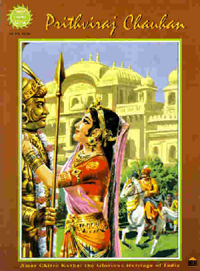|
Dear Visitor,
I welcome you to this non-profit, educational page. Here you
will read about different aspects of the history and culture of
that part of our globe which is known variously as Bharatvarsha,
Hindostan or India. My approach of looking at history is that of
a rationalist and humanist. As my aim is to spread awareness about history and culture, you
may freely download this page, print it, link it up from your
site, or mirror it at any server. Enjoy the infotainment laid
out for you at this site. I also look forward to your valuable
suggestions and feedback. Happy viewing.
Author
Hindu History
The Rajput Resistance to the Muslim Aggression
By Sudheer Birodkar
In the last chapter, we saw how the Muslim rule of the Ghaznivids was
established in Kabul, Paktoonistan and in the land of the five rivers - Punjab.
Thus after Sindh in 715; Kabul Paktoonistan and Punjab became the next Indian
provinces which went under Muslim domination in the period 980 C.E. to 1020 C.E.
 The refusal of the two Rajput Kingdoms of the Chauhans and the
Rathods (Gahadwalas) to unite in face of the Muslim invasion led to the
Fall of Delhi and Kannauj to the Muslims and led to the establishment of
Muslim Rule in India.
The refusal of the two Rajput Kingdoms of the Chauhans and the
Rathods (Gahadwalas) to unite in face of the Muslim invasion led to the
Fall of Delhi and Kannauj to the Muslims and led to the establishment of
Muslim Rule in India.
(Illustration courtesy India Book House (IBH). The illustrations
below pertaining to Prithviraj Chouhan are hyperlinked to the IBH site
and will take the viewer to the life stories of important Indian
personalities.)
The Rajputs
- Samurais from India
In spite of the Muslim rule up to Punjab, the Rajputs gained control of
the heart of North India. The Rajput (from Raj-Putra i.e. prince or literally
"king's son") who held the stage of feudal rulers before the coming of
the Muslims were a brave and chivalrous race. The Rajput legend traces their
ancestry to Bappa Rawal - the legendary founder of the race who is said to have
lived in the 8th century. In actual fact although they were Kshatriyas in the
Hindu caste hierarchy, they seem to have genetically descended from the Shakas
and Hunas who had invaded north India during the Gupta period and had
subsequently settled down in North India and due to their war-like atttiudes and
been absorbed as Kshatriyas into Hindu society. It is they who held the banner
when the first Muslim invaders reached the Indian Heartland in the 12th century
i.e. around 1191 C.E.
The Rajputs who till the 10th century were mostly local feudal lords holding
the status of revenue collectors for their Gurjara-Pratihara overlords, asserted
themselves as independent rulers, after the Ghaznavid storm had blown over, and
took over the earlier kingdoms of the Gurjara-Pratiharas. The main Rajput
kingdoms in the 11th and 12th centuries were that of the Cahamanas (Chouhans) in
East Punjab, Northern Rajasthan and Delhi. The Gahadwalas (Rathods ) ruled the
Ganges valley today's UP. The Paramaras ruled Malwa in Central India and the
Tomaras ruled from Gwaliar. The most powerful kingdoms were hose of the Chouhans
and the Rathods - both of which unfortunatley were incessantly at war with each
other when the Muslim raiders appeared again in the 1191 C.E. The Rajputs, (from
Raj-Putra i.e. prince or literally "king's son") who were a brave and
chivalrous race, held the stage of feudal rulers before the coming of the
Muslims.
Author: Shri Sudheer Birodkar
|